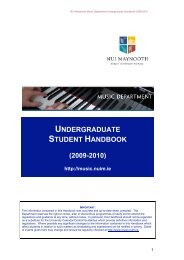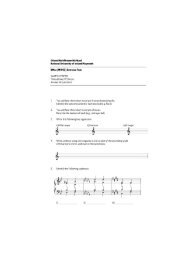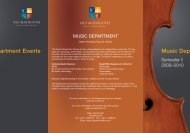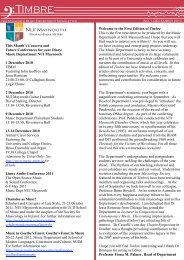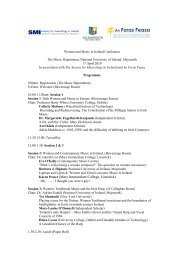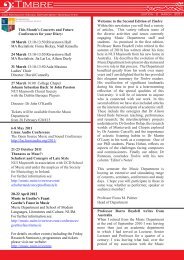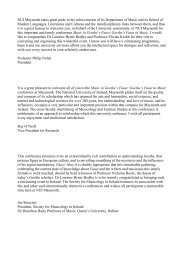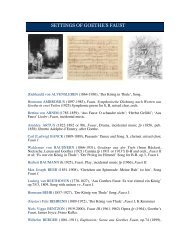Conference Booklet - Music - National University of Ireland, Maynooth
Conference Booklet - Music - National University of Ireland, Maynooth
Conference Booklet - Music - National University of Ireland, Maynooth
Create successful ePaper yourself
Turn your PDF publications into a flip-book with our unique Google optimized e-Paper software.
Harry White (<strong>University</strong> College Dublin)<br />
Death and the Maiden: Woody Allen and the Late Schubert<br />
Schubert‘s string quartet in G major, D. 887 (1826) is pivotally engaged by Woody Allen in his<br />
film, Crimes and Misdemeanors (1989) as a semantic code for death, guilt, remorse and crime<br />
itself. Given Schubert‘s own decisive encounters with German romantic poetry through the<br />
agency <strong>of</strong> his song settings, and given too the long reception history <strong>of</strong> these settings in the<br />
popular imagination, Allen‘s reading <strong>of</strong> the late instrumental music represents a significantly<br />
neo-romantic interpretation <strong>of</strong> Schubert in the dominant art form <strong>of</strong> our own day. Although this<br />
reading enjoys a number <strong>of</strong> interesting precedents in neighbouring art forms (including Samuel<br />
Beckett‘s radio play All that Fall [1952]), the context in which it appears in Crimes and<br />
Misdemeanors is an exceptionally arresting one. In particular, this context discloses a strategic<br />
sequence <strong>of</strong> contrasts between European and American modes <strong>of</strong> culture in which the rhetoric<br />
<strong>of</strong> Schubert‘s quartet is strikingly re-configured.<br />
Scott Messing (Alma College)<br />
What Late Style? Schubert’s Marche militaire and the Lure <strong>of</strong> Reception<br />
The Marche militaire No. 1 was printed in Vienna in 1826, five days before Schubert wrote to two<br />
German publishers <strong>of</strong>fering his latest works to a new market. The date <strong>of</strong> the march‘s creation is<br />
not certain, but to judge from one firm‘s letter to the composer a month before his death in 1828,<br />
what was still desirable from his pen was ‗anything easily understandable à 4 mains.‘<br />
More than any other instrumental work <strong>of</strong> Schubert, the march‘s subsequent<br />
efflorescence signals a far greater discontinuity between its endearing and enduring pleasures,<br />
and the transcendent heights and stygian depths that we <strong>of</strong>ten accord music attributed to the<br />
twilight <strong>of</strong> the composer‘s career. A ubiquitous presence after the middle <strong>of</strong> the 19th century,<br />
the march became stitched into the public consciousness: a work whose tenacity had few rivals<br />
in the popular imagination and was out <strong>of</strong> all proportion to its content.<br />
Because <strong>of</strong> the work‘s distinct historical fingerprints, there exists the possibility <strong>of</strong><br />
harnessing a reception study onto its slender musical shoulders and <strong>of</strong> <strong>of</strong>fering a narrative that<br />
illuminates the culture that enshrined its otherwise humble dimensions. For this presentation ,<br />
only a sketch can outline the paths by which the work acquired its place in the repertoire<br />
through a consideration <strong>of</strong> its many arrangements along with the institutions, performers, and<br />
venues that nurtured them. All contributed to the work‘s dissemination, even as its intrinsic<br />
musical values, so remote from those that typically adhere to a definition <strong>of</strong> a late style, were<br />
not decisive in securing its stature. Its gestures nevertheless were ones to which Schubert<br />
remained loyal throughout the 1820s.<br />
The omnipresence <strong>of</strong> the Marche militaire did not slacken despite Adorno‘s novel<br />
contention in 1928 that the world that includes Schubert‘s military marches ‗has as little to do<br />
socially with bourgeois, indeed parochial strumming as it ever has with the naïve affirmation <strong>of</strong><br />
existence.‘ Instead, contemporary technologies provided reincarnations <strong>of</strong> the work that seemed<br />
to realize Adorno‘s dreaded concern a decade later: the twinning <strong>of</strong> ‗vulgarization and<br />
enchantment.‘



